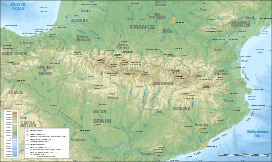Canigou
| Canigou | |
|---|---|
 Canigó, December 2004 | |
| Highest point | |
| Elevation | 2,784 m (9,134 ft) |
| Prominence | 550 m (1,800 ft) |
| Coordinates | 42°31′08″N 02°27′24″E / 42.51889°N 2.45667°ECoordinates: 42°31′08″N 02°27′24″E / 42.51889°N 2.45667°E |
| Geography | |
 Canigou | |
| Parent range | Pyrenees |
| Climbing | |
| First ascent | According to tradition, in 1285 by Peter III of Aragon |
| Easiest route | hike |
The Canigou (French pronunciation: [kaniɡu]; Catalan: Canigó [kəniˈɣo], locally: [kəniˈɣu]; el. 2,784.66 m./9137 ft.) is a mountain located in the Pyrenees of southern France.
Due to its sharp flanks and its dramatic location near the coast, until the 18th century the Canigou was believed to be the highest mountain in the Pyrenees.[1]
Geography
The Canigou is located in Pyrénées-Orientales, south of Prades and north of Prats-de-Mollo-la-Preste. Its summit is a quadripoint between the territories of Casteil, Taurinya, Valmanya and Vernet-les-Bains. Its location makes it visible from the plains of Roussillon and from Conflent in France, and as well from Empordà in Spain.[2]
Twice a year, in early February and at the end of October, with good weather, the Canigou can be seen at sunset from as far as Marseille, 250 km away, by refraction of light. This phenomenon was observed in 1808 by baron Franz Xaver von Zach from the Notre-Dame de la Garde basilica in Marseille.[3] All year long, it can also be seen, with good weather, from Agde, Port-Camargue and the Montagne Noire.
Trekking and sightseeing

Jeep tracks on the north side of the massif lead to the Chalet des Cortalets (at 2150 m) which is a popular outpost with walkers.
There are two ancient monasteries at the foot of the mountain, Martin-du-Canigou and Saint-Michel-de-Cuxa.
Canigou Flame
The mountain has symbolical significance for Catalan people. On its summit stands a cross that is often decorated with the Catalan flag.[4] Every year on 23 June, the night before St. John's day (nuit de Saint Jean), there is a ceremony called Flama del Canigó (Canigou Flame), where a fire is lit at the mountaintop. People keep a vigil during the night and take torches lit on the fire in a spectacular torch relay to light bonfires elsewhere.[5] Many bonfires are lit in this way all over Catalonia on that night.[6]
Literature
The Canigou inspired the epic poem "Canigó" by Catalan poet Jacint Verdaguer i Santaló. In these verses Verdaguer compares the snowy mountain to a Magnolia flower (pages 27–28):
| Lo Canigó és una magnòlia immensa |
The Canigó is an immense magnolia |
See also
Notes
- ↑ Histoire du Roussillon - Le relief des Pyrénées-Orientales
- ↑ Guide du Roussillon et de l'Andorre : touristique, historique, social, économique, Perpignan, Sud Roussillon, 1968, 286 p.
- ↑ Cárdenas, Fabricio (2014). 66 petites histoires du Pays Catalan [66 Little Stories of Catalan Country] (in French). Perpignan: Ultima Necat. ISBN 978-2-36771-006-8. OCLC 893847466.
- ↑ Pyrénées Team - Croix du Canigou
- ↑ Vermut a la rebuda de la Flama del Canigó
- ↑ Festes - l'espai on comença la festa
References
External links
| Wikimedia Commons has media related to Canigou. |
- Canigo.cat All information about the Canigou massif: nature, culture and itineraries (in Catalan)